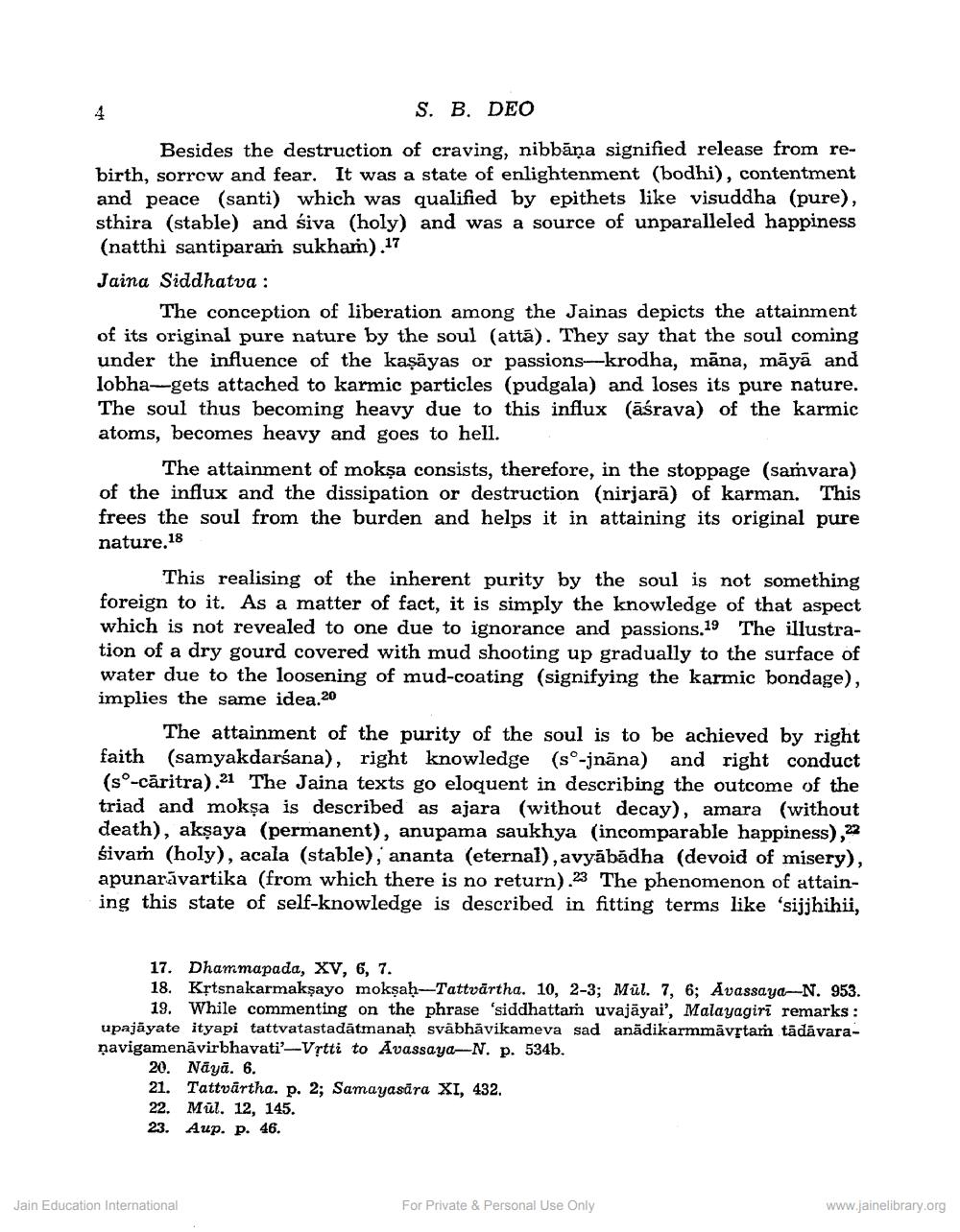Book Title: History of Jaina Monachism Author(s): S B Deo Publisher: Deccan College Research Institute View full book textPage 9
________________ 4 S. B. DEO Besides the destruction of craving, nibbāņa signified release from rebirth, sorrow and fear. It was a state of enlightenment (bodhi), contentment and peace (santi) which was qualified by epithets like visuddha (pure), sthira (stable) and siva (holy) and was a source of unparalleled happiness (natthi santiparam sukham).17 Jaina Siddhatva : The conception of liberation among the Jainas depicts the attainment of its original pure nature by the soul (attā). They say that the soul coming under the influence of the kaşāyas or passions-krodha, māna, māyā and lobha-gets attached to karmic particles (pudgala) and loses its pure nature. The soul thus becoming heavy due to this influx (āśrava) of the karmic atoms, becomes heavy and goes to hell. The attainment of mokşa consists, therefore, in the stoppage (samvara) of the influx and the dissipation or destruction (nirjarā) of karman. This frees the soul from the burden and helps it in attaining its original pure nature.18 This realising of the inherent purity by the soul is not something foreign to it. As a matter of fact, it is simply the knowledge of that aspect which is not revealed to one due to ignorance and passions. 19 The illustration of a dry gourd covered with mud shooting up gradually to the surface of water due to the loosening of mud-coating (signifying the karmic bondage), implies the same idea.20 The attainment of the purity of the soul is to be achieved by right faith (samyakdarśana), right knowledge (so-jnāna) and right conduct (so-caritra).21 The Jaina texts go eloquent in describing the outcome of the triad and mokṣa is described as ajara (without decay), amara (without death), akşaya (permanent), anupama saukhya (incomparable happiness), śivam (holy), acala (stable), ananta (eternal), avyābădha (devoid of misery), apunarāvartika (from which there is no return).23 The phenomenon of attaining this state of self-knowledge is described in fitting terms like ‘sijjhihii, 17. Dhammapada, XV, 6, 7. 18. Kftsnakarmakşayo mokṣaḥ-Tattvārtha. 10, 2-3; Mül. 7, 6; Avassaya-N. 953. 19. While commenting on the phrase 'siddhattar uvajāyai', Malayagiri remarks: upajāyate ityapi tattvatastadātmanah sväbhävikameva sad anādikarmmavrtar tādāvaranavigamenávirbhavati'-Vrtti to Avassaya-N. p. 534b. 20. Näyā. 6. 21. Tattvärtha. p. 2; Samayasära XI, 432. 22. Mül. 12, 145. 23. Aup. p. 46. Jain Education International For Private & Personal Use Only www.jainelibrary.orgPage Navigation
1 ... 7 8 9 10 11 12 13 14 15 16 17 18 19 20 21 22 23 24 25 26 27 28 29 30 31 32 33 34 35 36 37 38 39 40 41 42 43 44 45 46 47 48 49 50 51 52 53 54 55 56 57 58 59 60 61 62 63 64 65 66 67 68 69 70 71 72 73 74 75 76 77 78 79 80 81 82 83 84 85 86 87 88 89 90 91 92 ... 616
